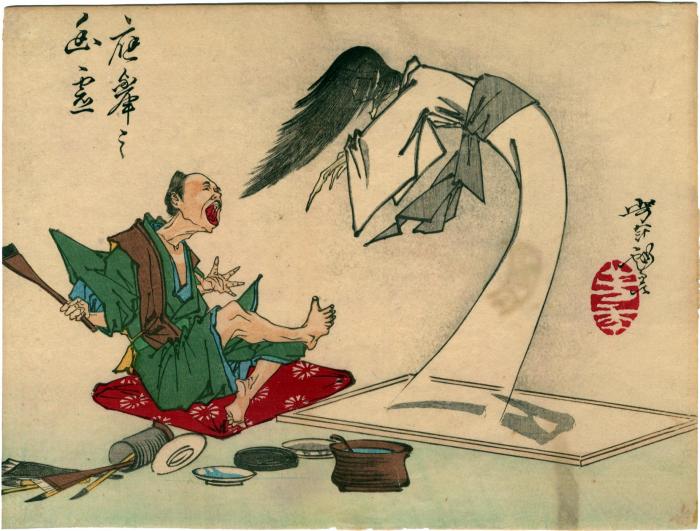Tsukioka Yoshitoshi (月岡芳年) (artist 04/30/1839 – 06/09/1892)
Ghost of Ōkyo (Ōkyo no Yūrei - 応挙の幽霊) from the series Yoshitoshi drawings (Yoshitoshi ryakuga - 芳年略画)
ca 1882
9.125 in x 6.875 in (Overall dimensions) Japanese woodblock print
Signed: Yoshitoshi zui hitsu (芳年随筆)
Artist's seal: Yoshitoshi
Hagi Uragami Museum of Art - full uncut sheet
National Diet Library - full uncut sheet
Rijksmuseum - full uncut sheet
Philadelphia Museum of Art
Walters Museum of Art
Museum of Fine Arts, Boston In 2007 a major European dealer in Japanese woodblock prints and drawings offered a Kuniyoshi sketch from ca. 1835 showing Nichiren painting an image of a woman that then rose up off the paper and materialized before him as a spectre. There is no known print of this subject, but the attribution appears to be solid. We mention this because Kuniyoshi was Yoshitoshi's teacher and he created this drawing approximately 50 years earlier than that of his pupil seen featured on this page.
****
Lafcadio Hearn wrote:
Tradition says that Okyo Maruyama was the first Japanese artist who drew a ghost. The Shogun, having invited him to his palace, said: 'Make a picture of a ghost for me.' Okyo promised to do so; but he was puzzled how to execute the order satisfactorily. A few days later, hearing that one of his aunts was very ill, he visited her. She was so emaciated that she looked like one already long dead. As he watched by her bedside, a ghastly inspiration came to him: he drew the fleshless face and long dishevelled hair, and created from that hasty sketch a ghost that surpassed all the Shogun's expectations. Afterwards Okyo became very famous as a painter of ghosts.****
The curatorial files at the Walters Museum of Art says:
The famous Kyoto artist Maruyama Okyo was well known for his true-to-life paintings. It was said that his flower paintings were so real that bees tried to pollinate them. Another story, illustrated by this print, tells of the time Okyo painted a ghost so "realistically" that it came to life and frightened him.****
Listed as #42.5 in Ing and Schaap, Beauty and Violence, but not illustrated.
Illustrated
1) in a small black and white reproduction in Catalogue of the Collection of Japanese Prints Part V - The Age of Yoshitoshi, Rijksprentkabinet/Rijksmuseum, 1990, no. 33, p. 32.
2) in a small color reproduction in Yoshitoshi's Thirty-six Ghosts by John Stevenson, Blue Tiger Books and the University of Washington Press, 2nd edition, 1992, p. 15.
3) in color in Yoshitoshi's Strange Tales by John Stevenson, Hotei Publishing, 2005, page 5.
****
Roger Keyes in his doctoral thesis on Yoshitoshi wrote on page 26 about an encounter with a ghost that that artist is said to have had in 1871. "It was probably during this spring also that the friends Yoshitoshi and Eitaku travelled to Ōiso with some pupils and stopped at a brothel in Shinagawa on their return. On his way to his room, Yoshitoshi was startled to see the ghost of a prostitute. The next day he learned that a woman had committed suicide there, and that her ghost appeared to most of the men who slept in her room."
Keyes also wrote on page 41: "Sometime before this date [1879], Yoshitoshi's former mistress Okoto died; soon after he moved to Nezu, her ghost appeared to him n the alcove of the guest room next to his studio. One result of this vision was that Yoshitoshi's interest in supernatural subjects returned; he designed a series of thirty prints of ghost subjects with the same type of irregular borders he used on the Thirty-six Supernatural Beings set in 1889.
Yūrei-zu (幽霊図 - ghosts demons monsters and spirits) (genre)
Meiji era (明治時代: 1868-1912) (genre)
